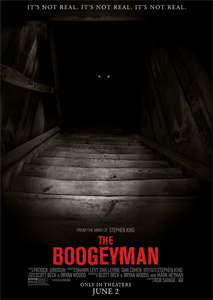“The Boogeyman,” adapted from a 1973 short story by Stephen King (collected in 1978’s “Night Shift”), is the third-oldest of his stories to be adapted into a major motion picture. Only “Graveyard Shift” (1970) and “The Mangler” (1972) are older. All predate his first novel, 1974’s “Carrie.”
I start my post with that bit of trivia because the film itself is, well, trivial. As adapted by director Rob Savage and three (!) writers, this is the tale of the universally recognized “monster under the bed/in your closet” from when you were a kid. “What if it was real?” the film asks.
Then there’d probably a period of convincing the adults, then an attempt to kill it. That’s what we get, over a period of 98 minutes that seems longer. Savage thinks he’s adding mood with the perpetual dimness of the Harper house, but it’s all rather funny for an experienced horror-watcher.
“The Boogeyman” (2023)
Director: Rob Savage
Writers: Scott Beck, Bryan Woods, Mark Heyman; based on the short story by Stephen King
Stars: Sophie Thatcher, Chris Messina, Vivien Lyra Blair
In the dark
The Boogeyman is loose in the house – older daughter Sadie (“Yellowjackets’ ” Sophie Thatcher), younger daughter Sawyer (Vivien Lyra Blair) and dad/therapist Will (Chris Messina) have all seen evidence of it.
Yet Sawyer plays a horror video game in the dark, by herself. The Harpers don’t deserve to be killed by the Boogeyman, of course, but they are asking to be scared with how they choose to light their home. (It’s implied that the Boogeyman has messed with the wiring, but no one is perturbed by this; they seem to like living in the gloom.)
“The Boogeyman,” which updates the timeless yarn to present day, is in that modern style where loud bangs accompany the monster jumping out. These are technically well-staged, but not scary in a novel way.
Sawyer rolls her moon glowball down a bend in the hallway, and we hear it crunch; the Boogeyman has smashed it. Then it’s 95 percent dark. And the Boogeyman will pop into the slightly less dark portion of the screen – with another loud bang. Scenes like this are so familiar – in the wider genre and in “Boogeyman” itself – that they engender a chuckle more so than fright.
Story’s simplicity illuminated
Thatcher, Messina and young Vivien make for a cute little family – grieving the recent off-screen loss of the mom – and individual scenes show strong acting. King’s overall grief/fear parallel is impressive for a 20-something short-story writer, but its thinness soon gets exposed.
Another of the messages: Sadie needs better friends. Aside from a bestie (Madison Hu’s Bethany) who is more or less by Sadie’s side, her “friend” group includes four girls who would be horrific enemies.
I guess the main point is “Believe your kids when they tell you the Boogeyman is real.” The metaphorical angle is “Have sympathy for your kids’ fears – they are real to them.” But that’s giving the film more credit than it deserves; it boasts three strong leads, but they aren’t asked to go particularly deep.
For better or worse, you’ll forget “The Boogeyman” faster than your kids will grow out of their bedtime fears.


